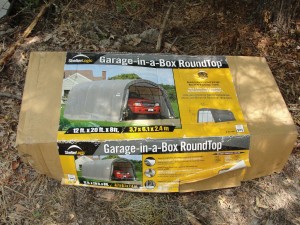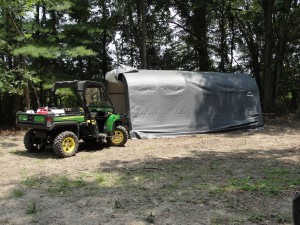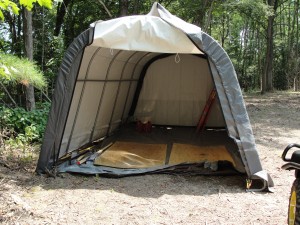When I purchased the Gator, I knew I couldn’t just leave it outside all year round.
The weather, bugs, sun, rain, snow, and miscellaneous forest creatures would all take their toll on it.
But I had a plan.
It turned out to be a fairly stupid plan, and one of my mistakes.

My plan was to buy a large, rectangular-shaped tarp. When I was done for the day in the woods, I’d lay the tarp out on the ground and drive the Gator over it. Then, I’d fold the tarp over the Gator, and lace up the sides with rope. This would create a Gator burrito, and the tarp would provide some protection.
While this plan was inexpensive, I soon realized that this was only slightly better than leaving the Gator exposed. It just wouldn’t provide enough protection.
- Bugs and other forest creatures could crawl into the tarp and nest in the Gator.
- Tree branches could fall on it.
- Wind would blow dust through the sides of the burrito tarp.
So I put away the big tarp and went to the internet for further research. There, I discovered a “Garage in a Box.”
Somewhat more expensive, this was more than just a tent. Among it’s key features were:
- Steel tubing on the inside
- Plasticized covering, UV resistant,
- Zippered openings
- Secure anchors that won’t pull out of the ground, short of a direct hit by a tornado.
- “Easily” assembled
I decided that this would provide a great deal more shelter for the Gator than the Gator Burrito, so I got one. They come in different sizes, and I needed the 12 x 20 to accommodate the Gator and also provide some space for storing other woods management tools.

The first clue that I had overestimated my construction capabilities occurred when it took three people, with effort, to load it into the back of the car. The shipping weight was 280 pounds. But I had dealt with heavy loads before. The picnic table weight problem was solved by opening the box and removing one piece at a time. I had the same plan for the Garage in a Box.
The next clue to the difficulty in building this became apparent after I had pulled out each piece from the box on a 92 degree day. The location I had selected had been cleared of trees and brush by the forest mulcher, seemed level enough, and was relatively close to the entrance to the woods. A good location, I thought. And in the end, I was right, but I hadn’t factored in the heat, humidity, and direct sunlight, making what should have been a pleasurable assembly into the 13th Labor of Hercules.
Assembling the steel tubes should have been easy for an old Boy Scout, but sitting out in the sun, they became blisteringly hot, requiring work gloves. (Work gloves on…insert one tube into another. Work gloves off…thread the bolt through the holes, attach a washer and a nut, and use a hex wrench to tighten the nut, while trying not to burn fingers on the hot steel tubes.)
Another problem was that not all the holes had been drilled through the poles. This required a trip into town to purchase an inexpensive power drill. Back to the woods. Fire up the generator I had purchased with the Gator, and drill the necessary holes. This was manageable, but added to the time of construction.
The biggest problem I encountered was that one person really can’t assemble this tent by themselves. It requires two, and three would have been better. I knew that even small camping tents could be assembled a lot faster with two people than one, but I also knew that with effort and creativity, one person could assemble any tent. Not so with Garage in a Box.
After all the main parts of the tubing are assembled, they need to be connected to each other, and this requires one person standing on a step ladder, holding tubing parts together (wearing gloves, because the steel tubes are disturbingly hot in the sun), while the other person brings up new parts, fasteners, and supports the other tubing while everything is being screwed down (and in some cases, screwed up. The bolts must be positioned so they always point away from the tent material…otherwise, the metal will dig through the tent.

Fortunately for me, my Forest Mulcher Guy’s son-in-law was helping out that day and came to my rescue. But it wasn’t until very late in the afternoon that the son-in-law, the Forest Mulcher Guy, and I finally got the last part of fabric tied down. In the meantime, we each consumed copious amounts of water to replace the drenching sweat.
After the Garage was up, I spread out a tarp to serve as a floor, and then laid two 4×8 plywood sheets down, to better distribute the weight of the gator whenever it was parked inside.
The Gator fit perfectly in the Garage, and I had plenty of extra room for storage of the other implements I’d been collecting. I was glad I’d built it, but it was a great deal more work than I had anticipated. Still, it was vastly better than my ridiculous Gator Burrito idea.
*Note: One year later, the Garage-Formerly-in-a-Box is still standing, despite rain, cold, snow, high winds, nearby tornados, and hail. I’m not still using it for the Gator, but that’s another story.
